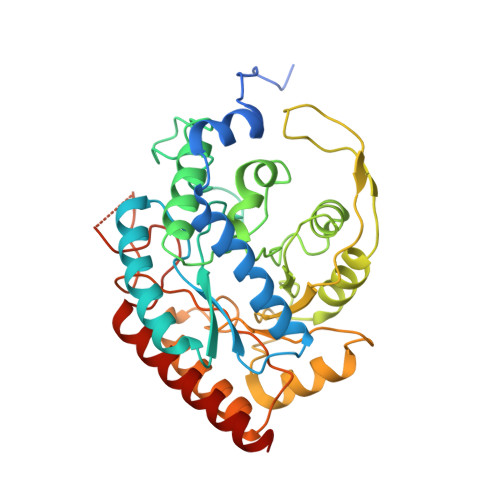Evolution of Feedback-Inhibited Beta /Alpha Barrel Isoenzymes by Gene Duplication and a Single Mutation
Hartmann, M., Schneider, T.R., Pfeil, A., Heinrich, G., Lipscomb, W., Braus, G.H.(2003) Proc Natl Acad Sci U S A 100: 862
- PubMed: 12540830
- DOI: https://doi.org/10.1073/pnas.0337566100
- Primary Citation of Related Structures:
1HFB - PubMed Abstract:
The betaalpha barrel is the common protein fold of numerous enzymes and was proposed recently to be the result of gene duplication and fusion of an ancient half-barrel. The initial enzyme of shikimate biosynthesis possesses the additional feature of feedback regulation. The crystal structure and kinetic studies on chimera and mutant proteins of yeast 3-deoxy-d-arabino-heptulosonate-7-phosphate (DAHP) synthase from Saccharomyces cerevisiae inhibited by phenylalanine (Aro3p) and DAHP synthase S. cerevisiae inhibited by tyrosine (Aro4p) give insight into important regions for regulation in the enzyme: The loop, which is connecting the two half-barrels, and structural elements added to the barrel are prerequisites for regulation and form a cavity on the N-terminal side of the betaalpha barrel. In the cavity of Aro4p at position 226 is a glycine residue, which is highly conserved in all other tyrosine-regulated DAHP synthases as well. Sequence alignments with phenylalanine-regulated DAHP synthases including Aro3p show a highly conserved serine residue at this position. An exchange of glycine to serine and vice versa leads to a complete change in the regulation pattern. Therefore the evolution of these differently feedback-inhibited isoenzymes required gene duplication and a single mutation within the internal extra element. Numerous additional amino acid substitutions present in the contemporary isoenzymes are irrelevant for regulation and occurred independently.
Organizational Affiliation:
Institut f¨¹r Mikrobiologie and Genetik and Abteilung f¨¹r Strukturchemie, Georg August Universit?t, D-37077 G?ttingen, Germany.

















